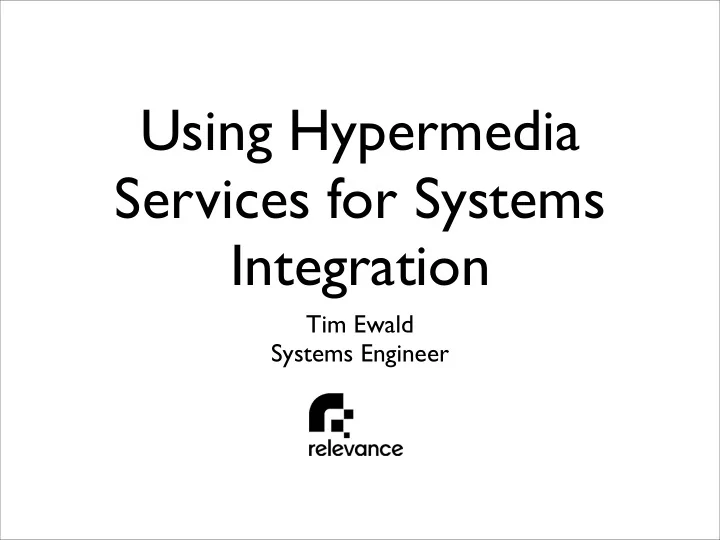

Using Hypermedia Services for Systems Integration Tim Ewald Systems Engineer
I dig REST services • My first choice when... • I don’t build both ends of pipe • I do build both ends of the pipe, but I can’t deploy them en masse
Real, pragmatic benefits • Evolution • Routing • Caching • App recovery • Vendor-free tooling
Evolution • Self-delimiting markup lets data evolve • Document-centric mindset is key • Use what you need, ignore the rest • Only breaks when it has to • Hypermedia extends this, lets behavior evolve
Evolution w/ markup <ns2:assets xmlns:ns2="..." xmlns="..."> <ns2:asset> <ns2:id>10</ns2:id> <ns2:title>foo</ns2:title> </ns2:asset> </ns2:assets> <ns2:assets xmlns:ns2="..." xmlns="..."> <ns2:asset> <ns2:id>10</ns2:id> <ns2:title>foo</ns2:title> <ns2:description>bar</ns2:desription> </ns2:asset> </ns2:assets>
Evolution w/ hypermedia <ns2:assets xmlns:ns2="..." xmlns="..."> <actions/> <ns2:asset> <actions> <action method="get" name="details" href="/assets/10"/> </actions> <ns2:assets xmlns:ns2="..." xmlns="..."> <ns2:id>10</ns2:id> <actions> <ns2:title>foo</ns2:title> <action method=”post” name=”create” <ns2:description>bar</ns:desription> href=”/assets” body=”ns2:asset” /> </ns2:asset> </actions> </ns2:assets> <ns2:asset> <actions> <action method="get" name="details" href="/assets/10"/> </actions> <ns2:id>10</ns2:id> <ns2:title>foo</ns2:title> <ns2:description>bar</ns:desription> </ns2:asset> </ns2:assets>
Consuming hypermedia assets = RESTUtil.invoke :get, 'http://localhost:9292/assets’ assets.asset.each do |asset| puts "#{asset.get_id}, #{asset.title}" # get detailed description if service supports that action puts asset.actions.details.description if asset.actions.respond_to? :details end # create an asset if service supports that action if assets.actions.respond_to? :create asset = com.schange.schemas.atria.assets.Asset.new asset.title = "baz" asset.description = "baz" details = assets.actions.create asset puts "#{details.get_id}, #{details.title}, #{details.description}" end
Caching • Caching helps scaling • Gives server some control over load • Decouples client load from back-end • Output caching on server farm • Client caching, or at least caching proxy • Need this for Etags to be useful
Routing • Hypermedia controls let service control where client sends requests • Dynamically generated based on any criteria • Server topology can change w/o updating clients • Adding bulkheads • Trying out new features • Maintenance
App recovery • Simple pattern for resolving lost responses • Slightly more complex for async pattern • Idempotent operations repeated as necessary • Save durably to restart after crash • POST -exactly once semantics if necessary
Ok, so how to build it? • Build (at least) one yourself! • Four steps... • Design protocol state machine • Design representations • Build service • Build client • Keep the visual Web in mind, but understand the critical difference
Protocol State Machine • A way to model about conversations • Separate from model for app state • Hidden in RPC behind method invocations to single endpoint • Exposed in REST by explicit requests to linked endpoints
Ticket PSM Tickets Ticket Checked-In Ticket
RPC hides PSM CheckInSystem Tickets interface CheckInSystem Ticket { TicketList Search(Query query); Ticket GetTicket(string number); bool CheckIn(Ticket ticket); Checked-In Ticket }
REST exposes PSM • PSM is graph of resources • Resource representations includes hypermedia controls forms for valid transitions • States traversed via HTTP requests • Current conversation state is latest {verb, URI, representation}
REST exposes PSM GET /tickets Tickets GET /tickets?... Ticket GET /tickets/{number} PUT /tickets/{number} Checked-In Ticket
Resources • Structure reflects external projection of info model • Use standard self-delimiting syntax • XML, XHTML, JSON, Clojure • Actual structure varies by service • Implies out-of-band knowledge • MIME type necessary, but insufficient
Hypermedia controls • In-band or out-of-band description of controls? • How decoupled can client/service be? • Is in-band documentation enough? • Links with semantics • xlink, href, something custom • URL templates, query params? • Forms are problematic
Building services • Implement with handler or MVC framework • Derive structure from PSM • Must support relative URL generation for hypermedia controls • e.g., url_for • Generate representation as view of data
Building clients • Generic “shapeless” or “auto-shaped” proxy • Must support URL resolution • Full tree navigation, pickling, zippers, etc • Should support redirection • Might support cookies, but only for auth • Fantastic if it supports caching, or use proxy
Literate Services • “But how do you know what a service does?” • Service describes itself, just add prose and use it from the browser too • Exploration • Integration • Debugging • Is this in-band enough?
Is hypermedia worth it? • Provides significant flexibility, but does it cover required cases? • Is overhead on wire, in storage too high? • Is cognitive dissonance for developers too high? • Is “loosely-coupled” the new “reusable”?
Recommend
More recommend